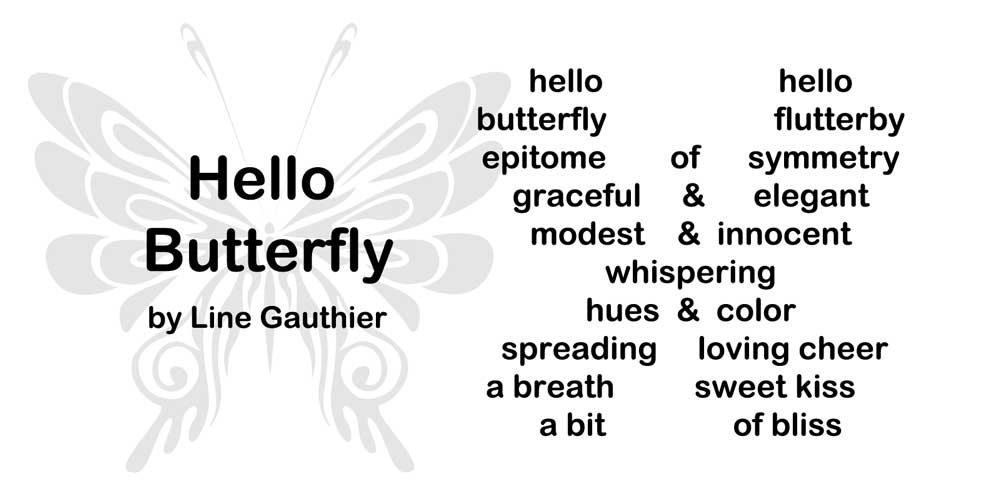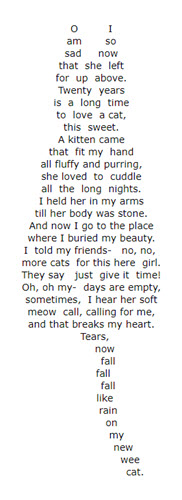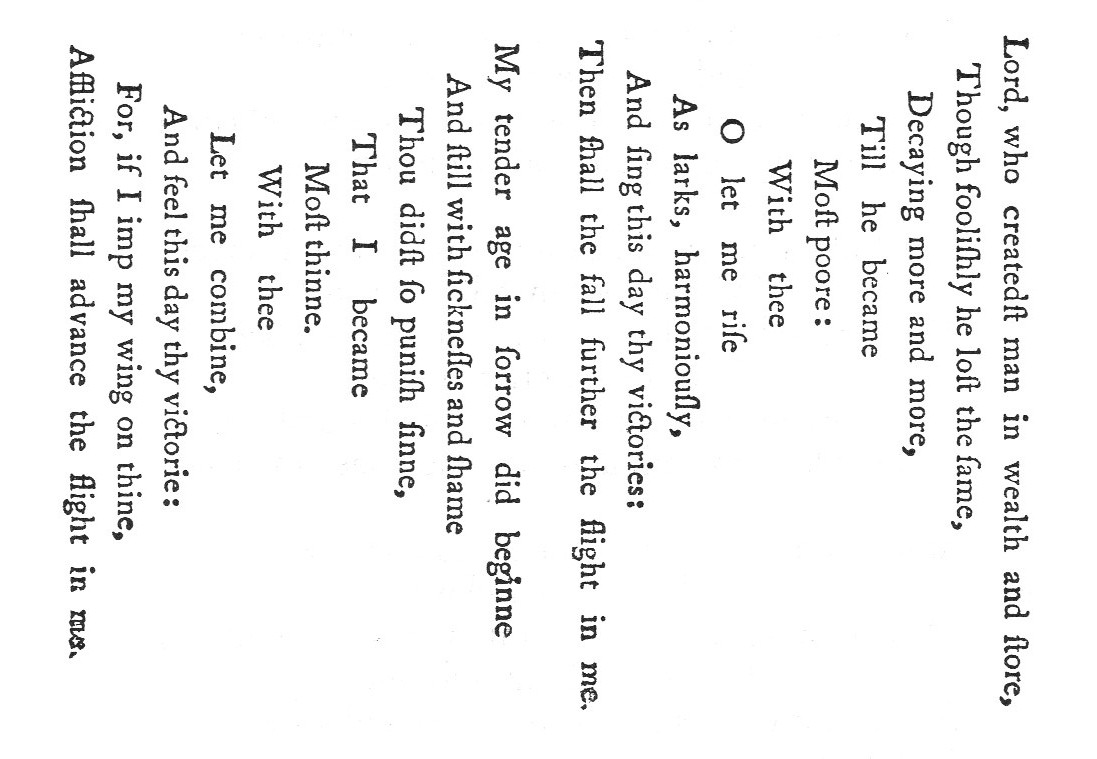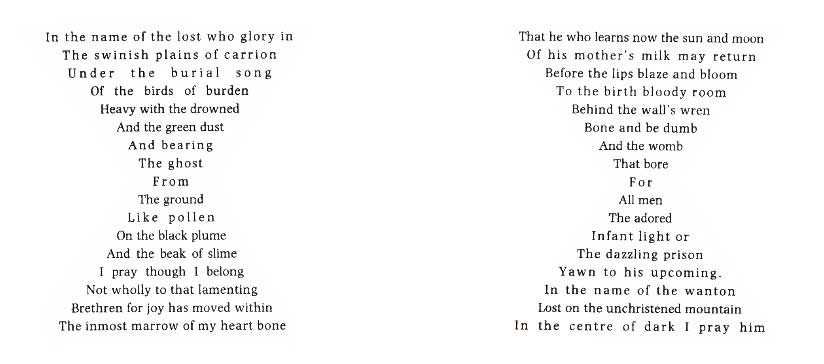Concrete poetry is a visual type of poetry that conveys its intent through the graphic patterns of words, symbols, and letters instead of only communicating it through words. Concrete poems take the shape of the object it describes. This is different from a Shape poem, in that Shape poems do not have to take the form of the object it describes.
In this form of poetry, the physical arrangement of the words is more important than the meaning of the words used. It is often called visual poetry because it relates more to visual arts than verbal arts, even though there is considerable overlap between the graphical representation and the words used.

In concrete poetry, the writer uses typographical elements such as typeface in a way that the selected units —words, letter fragments, graphemes (letters), syllables, or morphemes) —and graphic spaces create, an evocative image.
How to Write a Concrete Poem
When writing a concrete poem decide what you want to write about. Remember, there are no specific rules for developing this form of poetry, meaning that you have the freedom to let your thoughts run wild and develop any story about any theme you would like.
The shape can be something that will represent your writing well. It could be a star, heart, or animal shape, etc. Now draw your shape onto a piece of paper with your pencil. As you think about your picture or shape, begin to think about a list of words that describe your picture. Write them down on your paper. Now, as you begin to think about words that describe your picture, think about the poem that you will use with these words to compose your concrete poem.
As your poem is developed, you should begin to see a story that is happening right in front of your eyes, about the shape that you have drawn. The Concrete poem is simply a shape that you have imagined and then created a poem around the words that describe your shape.
Concrete Cat
by A Dear Heart

There are no rules about the length of this form of poetry, but it would help to remember the more phrases or words you use, the bigger the shape of the poem would be. This means that you must first pick the shape of the poem you want to create: if your reader views your work from a distance, they would be able to tell the outline of the shape; however, they would only be able to read the words when they are close enough.
Knowing this, perhaps you should consider picking a simple shape if you are looking to start out. Besides, the shape should relate to the meaning of the poem you are writing. For instance, if your poem is about armed conflict, your poem should assume a sword shape. And if the poem is about the theme of love, the shape of a heart would make more sense.
Furthermore, you do not require an artist to draw an outline of the shape to make it eye-catching. Instead, you can outline the shape of the poem using a computer program or using a paper if you wish to write your poem by hand. It would help to remember that the selected units used to create this form of poetry are just as important as the shape they create. As such, you can experiment with colors, italics, or bold to add texture to the words and ensure that the shape you create look 3-D. With the computer program’s use paste the units of the poem, you wave created onto the shape outline to create an original poetic image.
Concrete Poem Examples
Triangle
I
am
a very
special
shape I have
three points and
three lines straight.
Look through my words
and you will see, the shape
that I am meant to be. I'm just
not words caught in a tangle. Look
close to see a small triangle. My angles
add to one hundred and eighty degrees, you
learn this at school with your abc's. Practice your
maths and you will see, some other fine examples of me.
Origin and History of Concrete Poetry
The term’ concrete poetry’ is widely considered to be contemporary, but the concept of utilizing the letter arrangement which augments the meaning and theme of the poem is old.
The practice of using letters to create shape poetry was common in Greek Alexandria, especially during the third and second BCE, even though only a few of those works of art now survive. The most notable examples are the works of Simmias of Rhodes, which assumed the shape of a hatchet, wings, and an egg. However, it was not until the 1950s that the term concrete poetry was coined by European artists Öyving Fahlström and Max Bill. The Viena Group of Konrad Bayer, Gerhard Rühm, and Hans Carl Artmann also promoted this form of poetry, as did Friederike Mayröcker and Ernst Jandl. This movement is believed to have drawn inspiration from Surrealism, Dada and other non-rational movements in the 20th century. During this era, the concrete poem was created to be abstract and without reference to an identifiable shape. Later, visual artists such as Ezra Pound and E. E. Cummings, who had an interest in ideograms, incorporated the typographical innovations. The movement spread across Europe, and by the time it reached its height of popularity in the early 1960s, this form of poetry had become less abstract. Several conventional poets then adopted concrete poetry as a unique form of poetry rather than a combination of visual art and literature.
Famous Poets Who Wrote Concrete Poetry
Easter Wings

Dylan Thomas is one of the most renowned English Poets noted for his ingenious, original, and rhythmic use of words and imagery. His status as one of the greatest modern poets remains popular among the public. His refusal to align with any movement or literary group made his work of art challenging to categorize. Some argued that he was influenced by modern surrealism and symbolism. Others view Thomas Dylan as part of the romanticism and modernism movement. However, efforts to pigeon-hole within a specific neo-romantic school proved to be unsuccessful. It is argued that Dylan Thomas did not care much about the meaning of what he created: he collected a list of striking words and slotted them into his poem, where he believed it sounded good. Here is part of a famous example of a concrete poem written by Thomas titled Vision and Prayer:

Gabriel Rosenstock is an Irish writer, playwright, poet, and author of over 180 books, including thirteen volumes of poetry and others in the Irish language. A member of Aosdána Gabriel Rosenstock has given reading in North and Central America, Europe, Australia, India, and Japan. Gabriel Rosenstock is also renowned for his work in concrete poetry.
Related Terms
absolute, actual, adamant, adobe, agglomerate, agglomeration, appreciable, ashlar, asphalt, associate, authentic, bitumen, bituminous macadam, blacktop, block, body, bona fide, bone, bony, bracket, breccia, brick, bricks and mortar, bunch, cake, candy, ca